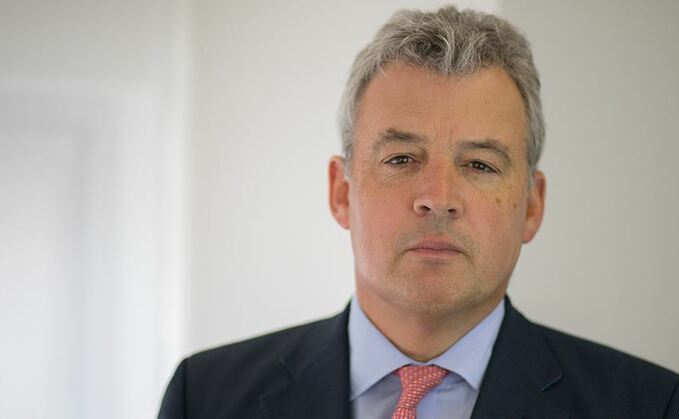
Schroders Solutions' James Barham: Meeting our clients' needs
It is now just over seven months since Schroders completed the acquisition of River and Mercantile Group’s UK solutions division at the beginning of February – merging it with Schroders’ existing solutions team and renaming the business unit as Schroders Solutions.
As a result of that deal, James Barham - River and Mercantile's founder and chief executive - became executive chairman of the newly combined Schroders Solutions to bring together the businesses and help deliver the opportunities generated by the partnership.
Barham says that, while the merger was in one way like starting a new business afresh - with new teams coming together and working under a new brand - it was also able to build on the reputation of both River & Mercantile and the broader Schroders business.
But he says the "marriage" of the two businesses under the "instantly recognisable" Schroders brand is something that is becoming increasingly important at the current time.
He says: "We are going through a stage in the cycle where things like brand, things like scale, things like operational scalability are really important factors.
"We've been through other stages where the boutique, the slim and the nimble was very much the passion. But I think we're at a stage now where, as the market develops and as pension fund needs change, the need to have brand scale and operational resilience are more important than they have been at any other time."
Integration
But how is the integration of the two businesses going? Barham says that, while many people may assume it is simply a matter of "pushing it all together and taking everyone out for a drink", it is much more of a long-term effort to get such a project right.
He says: "Integration is a long-term process. It is something you have to invest in - in fact, all studies have suggested the more the host company invests in that integration, the more successful it's likely to be and Schroders has invested very significantly in making sure that that integration works."
Barham said this investment started as soon as the deal was announced - with people being brought into Schroders' building to get a sense of the environment they would be working in and getting a chance to meet their counterparties as well as an understanding of the culture and purpose of the organisation.
The actual office move in February, he says, was relatively seamless - enabling the combined solutions team to deliver a seamless service to all of its clients.
He says: "The one thing you can't afford is a break in that service, because while clients might give you the benefit of the doubt, patience can be quite thin, so it is really important that all of your people are able to continue functioning as they did the previous day. And that was very much the case here."
From there on Schroders Solutions has been working to blend the two businesses together and ensure the market is very clear about its offering - something it says comes back to the fact that the two businesses didn't have many conflicting services.
Barham explains: "The acquisition of the River & Mercantile solutions business strengthened an area where Schroders needed to grow - particularly on the fiduciary management side. Schroders had been very successful in beginning to develop and build an OCIO and managed account business, but in terms of providing a market leading fiduciary service, bringing the River & Mercantile business in really completed that element of that jigsaw."
He said while there were areas in which there were some commonalities - both businesses, for instance had significant liability-driven investment and derivatives operations - but the fact that there was so little overlap overall meant that the integrating, broadening and deepening these services was "a relatively straightforward thing to do".
Systems integration
A perhaps less straightforward thing to do is integrate the systems of the two organisations, the work for which is currently underway. This however has been assisted by work that had already been started by River & Mercantile before the deal with Schroders.
Barham says: "It's been helped by the fact that we had done a lot of the preparation work at River & Mercantile prior to that, because when we merged River & Mercantile and P-Solve back in 2014, we never moved both of those businesses on to a common operating platform.
"Part of my strategy as group CEO at River & Mercantile was to move the business onto a common operating platform - so we had done all the vendor identification, vendor negotiation, all the preparatory work to be able to move on to a new operating platform, we just didn't do it because it was then very clear we were going in a different direction in terms of the business being broken up."
Barham adds: "It meant that all of that preparatory work had been done, but instead of having to point it towards a different operating platform, we're pointing it to Aladdin, which is the main operating architecture and infrastructure which is used within Schroders and we will gradually move the business on onto that over the next nine months."
A broad business
Once fully integrated, Schroders Solutions will have assets under management of over £200bn - not just in the pensions market, where it has had some sizeable wins over the past year, including the £10bn Centrica OCIO mandate announced in April, but also in the insurance markets, where both businesses had a heritage and Schroders has just been appointed by Lloyd's of London as a partner for its new investment platform. In addition to this, the firm also has a number of defined contribution fiduciary mandates.
Yet while, Barham is keen to point out that Schroders Solutions works across more than one market, he is also keen to note why he believes the organisation is different and what he feels makes it stand out in the pensions space in particular.
He says: "We combine a number of factors, a number of cultures, which make us stand out. If you look at the fiduciary market, you have either got those fiduciaries with a consulting heritage or those fiduciaries with an asset management heritage. I think we combine those very much together."
Barham speaks about the firm's strong consulting heritage going back to its P-Solve and the formation of the fiduciary market in the early 2000s - noting the organisation's consulting mindset in terms of its engagement process with clients.
He says: "It's very much on trying to understand both their financial need, but also their emotional need, and then being able to design a solution which is specific to them. Like anything, it will have common building blocks, but each pension fund has a specific set of needs because they're not all the same - they have different sets of liabilities, they have different individuals governing them, they have different timeframes and sponsors and different strengths of covenant, there are a whole range of factors which differentiate each pension fund."
But Barham says that, while his business looks at these issues from a consulting mindset it does so from within an asset management business - something that gives it access to a wide range of investment skills.
He explains: "This is totally different than you get in a typical consulting business. And being able to balance all of that together puts us in a very strong position to be able to deliver ultimately what our clients funds are looking for."
Going for growth
As a former chief executive of a public company who is now part of another PLC, Barham is cautious about making financial forecasts but points towards comments that both Schroders group chief executive Peter Harrison and himself made at the time of the River & Mercantile acquisition noting the deal was very much about growth.
He says: "This is not about driving cost synergies. This is all about growth. And that's growth in clients, it's growth in our assets and it's growing our business to be able to improve the returns and improve the outcomes we generate for clients."
Barham sees opportunities for growth in a number of areas, not least in consolidation - noting that, while recent rate rises have brought the timeframes of a lot of pension funds forward in terms of when they can start looking at potentially buying-in and buying out their liabilities, there was still a lot of opportunity in the market.
He explains: "You've still got a very fractured and disparate industry of around 5,500 defined benefit pension funds in the UK, with around 3,800 below £100m in size. Fiduciary management to a certain extent is the first stage of consolidation in terms of you are bringing together all of your investment decision making into one organisation."
But Barham believes consolidation could go further. He says: "If you look at all of those schemes, they're all still paying separate audit fees, they're all paying separate admin and actuarial fees - there is a lot of leakage of value which takes place as a result of that fractured nature of the industry. And we know the Department for Work and Pensions, the regulators and the industry all recognise that there needs to be change and there needs to be consolidation."
Barham believes there is a need for the industry as a whole to look at how it can help drive consolidation and, as a result of that, lower costs and improve returns for schemes - but notes this is something his business will also be looking at.
He says: "This is something which I would like to see us focus on. It is something which we are looking at very closely and assessing the structures and the solutions which we can bring and where we can work with our colleagues and partners within the industry - whether it's with sole trustees, independent trustees, or with trustees more generally - to be able to deliver the right outcome for members.
"Consolidation provides a huge opportunity and, within that, fiduciary management has a real role to play."
A move closer to endgame
While many schemes are much closer to being able to buy out their liabilities, many of them are not necessarily there at the moment. But, these schemes can, says Barham, make "material change" to how they have structured their portfolio - an area where Schroders Solutions also sees opportunities.
Barham explains the need for significant elements of growth within that portfolio tends to fall away as schemes get closer to endgame so developing solutions around cashflow-driven investment solutions is key and an area where Schroders has a strong offering.
"This is, to a certain extent, the next step towards buyout - you are not just going from a portfolio which has significant amounts of growth in it to a buyout overnight, you tend to go through this halfway house to get there. We're working with a lot of clients in terms of being able to provide that solution, but I think that, as a house, we also then need to look at buyout more generally in terms of what we can offer in that space."
Yet, while it is clear that, as schemes reach endgame, there may be much less for fiduciary managers to do as they reduce growth asset holdings and ultimately go to insurance buyout, this is not something that overly concerns Barham.
He says: "Ultimately, at the end of the day, you have to come back to our purpose, which is to solve the deep financial challenges faced by some of some of our clients. If we can take a client from a poorly funded position, through to a position where they are able to buyout those liabilities and meet their objectives, that's the best advert we've got."
Barnham says that Schroders wants to be able to provide a solution which allows a trustee group "continuous governance" from their current position, through to a CDI arrangement and then into buyout - staying with the firm throughout the process.
He adds: "We have a lot of the capabilities and skills required when you're looking towards buyout within this building."
Barnham points towards Schroders Capital, Schroders' private markets business, which he says can deliver a lot of the investments required to deliver the sort of contractual cash flows which are needed at that stage of life, whether it be within CDI or buyout. How we develop that and enhance that is something which we will be talking more about in due course."
And Barham also notes that, as a business, Schroders works with a number of insurers too - meaning they can potentially continue the relationship with scheme assets even after buyout.
He says: "It's not a fact that all of the assets disappear out of the building - many of the assets remain with us because we have the skill sets to continue to be able manage them in a way which meets our clients' needs."








